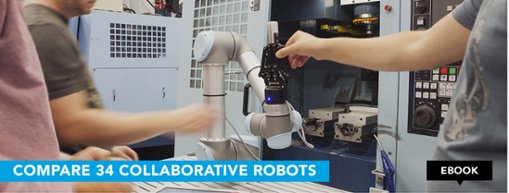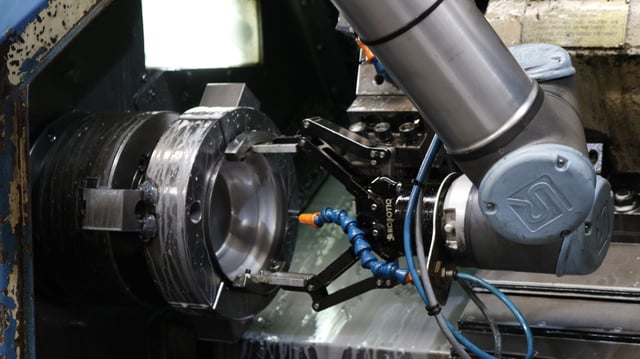Collaborative Robots for Job Shops: How to Make it Work

Posted on Jan 17, 2018 7:00 AM. 5 min read time
Can you really use collaborative robots in a high-mix, low-volume process? Yes! … and here's how to make it work.
In a previous article, we explained how collaborative robots can work just as well in job shops as they can in flow shops.
"Job shop" is a way of describing a manufacturing environment without a consistent machining sequence. The opposite is a "flow shop" where all operations are arranged into a consistent production line. Job shops are common in small manufacturing businesses where there is a low volume, high mix of products.
Until recently, it was hard to apply robots to job shops because of the inconsistent orders. Traditional automation was inflexible and job shops require high flexibility. This all changed when collaborative robots arrived because they are inherently flexible to changes.
There are still challenges for using cobots in a job shop, but it is easier than ever to make them work, as long as you follow the right process.
6 Steps to Making Cobots Work for a Job Shop
Unlike flow shops, which we covered in a previous article, job shops require a bit of preliminary "process wrangling" before you can integrate a collaborative robot.
Remember that robots don't cure a bad process. The robot will only ever be as efficient as the rest of your manufacturing line. This is particularly important in job shops because of the inconsistent flow between operations. You can't just "throw" a robot into any task and expect to improve productivity — you have to pick the right task and integrate it properly.
Here are six steps for integrating cobots into a job shop.
1. Work Out Your Routings
A useful first step is to plot the route that each product takes through your process. This can be complex. As we explained in our previous article, job shop sequences can look a bit like this:
Start by looking at one particular job and plotting its route through the machine shop. You could use the product which takes the longest to produce.
For example, you might define a sequence for a product which looks like this:
Lathe -> CNC Machine -> Milling Machine -> Lathe -> Drill -> CNC Machine -> Lathe -> CNC Machine -> Packaging -> Palletizing
Identify which steps in the process take the longest to complete and which operations are repeated. This helps you to understand the work flow of the product, which will help to pick the right operation for your robot.
2. Identify Bottlenecks
Look for machines or production steps which cause bottlenecks. These can be good candidates for collaborative robots.
Signs of potential bottlenecks might be:
- Work in Progress piles up before a particular machine.
- Jobs which go through this machine take a lot longer to produce than jobs which don't.
- Production effectively halts when someone is not operating the machine.
- There is an ever-growing backlog of products — i.e. more jobs are coming into the workshop than are going out of it.
A collaborative robot may be able to help you tackle the bottleneck. However, you first have to trace the cause of that bottleneck to ensure that you are applying the robot to the right task.
See our article Scaling Up from 1 to 10 Robots: Gather Information for more information on solving bottlenecks with collaborative robots.
3. Where Possible, Optimize Manual Processes
During the previous two stages, you may discover ways to optimize the manual processes in your manufacturing line. This often happens when you formalize a process. Now is a good opportunity to improve any inefficiencies, even those which will not involve robots.
4. Apply Robots to a Bottleneck or Non-Value Added Task
Introduce a collaborative robot to one specific task within the process. Pick a task which either causes a bottleneck or is repetitive and does not add value to the product.
For your first application, start simple and pick a task which does not require extra sensors or complex programming. You can maximize your chances of success by learning more about cobots. Check out our Getting Started With Collaborative Robots series to give yourself a head-start.
Because job shops are a complex manufacturing environment, it is a good idea to introduce robots to one task at a time and track their influence on particular product lines. After you have proved the first robot is effective, you can apply one to a different task.
5. Measure Cobot Performance
You will not be able to determine the success of your robot unless you objectively measure its performance. This can be tricky in job shops, where it is hard to apply traditional production metrics.
Here are three steps for effectively measuring cobots in a job shop:
- Gather production data for your chosen task before you integrate the robot. This gives you a baseline of performance.
- Integrate the robot and track the performance of that task. Gather as much data as you can over time.
- Compare data before and after the robot integration.
When you have proved that the robot is effective, you can reduce the amount of data you are gathering if the data collection is becoming unwieldy.
6. Look for Ways to Reuse Robots
Inconsistent orders are a big challenge for job shops. Customers appear and disappear regularly. You don't want to invest in a new piece of technology for one big order only for the customer to cancel that order three weeks later and leave you with a useless machine on your hands.
Collaborative robots are well suited to job shops because they are easy to redeploy. You can even use the same robot on multiple tasks in the same day — just wheel the robot across the shop floor, place it next to another work station and start it.
Always keep an eye out for new tasks to which you could apply the robot. If one task suddenly becomes less important for your productivity, you will have a list of alternative tasks to get started on immediately.
What challenges do you encounter in a job shop environment? How could a robot help you to improve productivity? What is your biggest fear about introducing automation to your production line? Tell us in the comments below or join the discussion on LinkedIn, Twitter, Facebook or the DoF professional robotics community.





Leave a comment